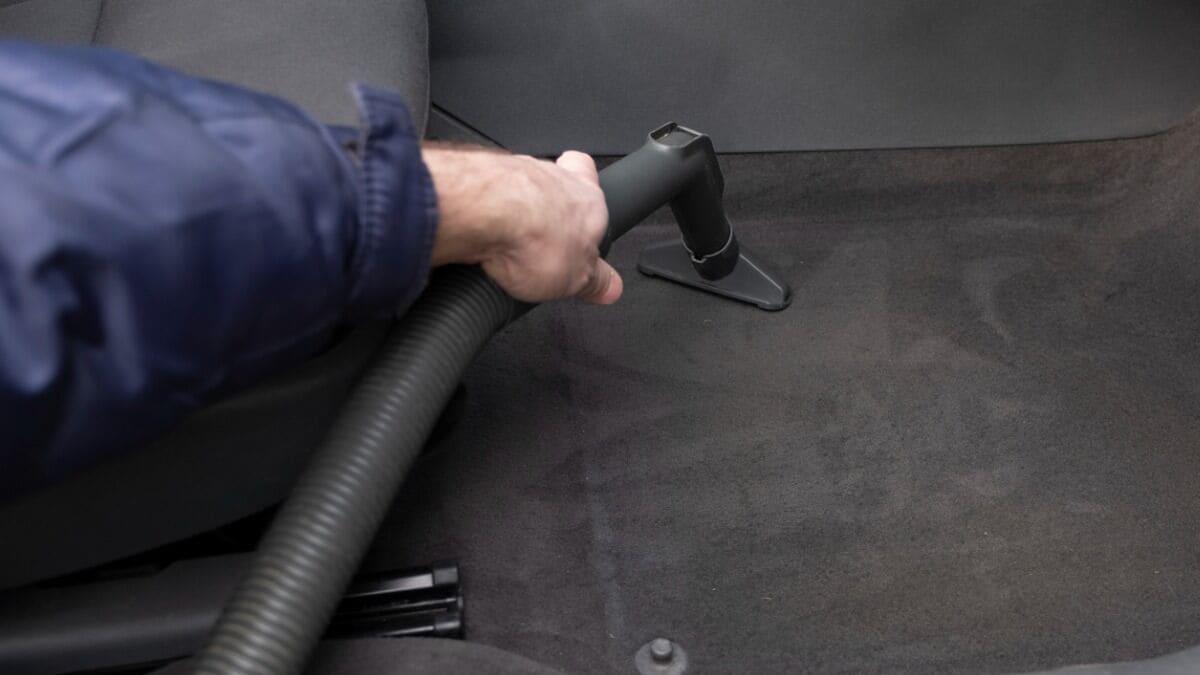A roach infestation in your car will make you want to take public transportation for a few days. These gross bugs can find the tiniest opening in your vehicle and turn it into their home. Luckily, with the proper steps, you can prevent infestations of cockroaches, ants, and other bugs. If creepy-crawlers have already taken control of your car, read on.
While keeping your car clean of dirt and crumbs helps, even the cleanest vehicle can be susceptible to a roach or bug invasion. Follow these steps to avoid seeing any bugs when driving your car.
How to Get Rid of Roaches and Ants in Your Car

Roaches, ants, and other bugs can be tricky to get rid of. The first step to getting rid of pests inside your vehicle is to meticulously clean the inside of it.
Thoroughly vacuuming will help eliminate food crumbs and get into all the cracks and crevices around the inside of your vehicle. After vacuuming, use blasts of compressed air to loosen crumbs and egg casings from tight areas, such as seat tracks, upholstery seams, and vents. Vacuum once more after using the compressed air. After the car interior is cleaned, you can address the invasion or infestation with one of these options:
- Bait stations: Gel baits and commercial bait stations can be more effective than sprays for types of roaches that nest within the vehicle because the pests take the bait into their nesting area. Set these stations in problem areas around your car, most likely under the seats, in the trunk, center console, and glove compartment.
- Sticky, glue-based traps: If the bugs aren’t the nesting variety, using specialized sticky strips or pads can be effective. Place them on your car’s floor in out-of-the-way places to trap the pests.
- Call a professional: If all else fails, you can always call an exterminator to eliminate pests in your vehicle.
Avoid using aerosol insecticide sprays inside of your car. The small cabin increases the concentration of harmful fumes and residue. Some insecticides can stain or damage leather, vinyl, surfaces, and trim surfaces. If you choose to use a spray, you must have ventilation while using and afterward. Carefully follow the instructions and understand the safety warnings on the can. More is not aways better. Test the product on a hidden area before spraying all over the inside of the vehicle.
RELATED: What Does It Mean to Have a Vehicle Detailed?
Can I Use a Bug Bomb in My Car?
As with spray insecticides, avoid using bug bombs. According to Orkin, they are useless and will not help eliminate bugs in your car. The bomb may ruin your car seats and cause cosmetic damage to the interior, which may decrease your car’s value.
How Bugs Get in Your Car
Roaches and ants are pesky insects that constantly search for food. Cars can be warm in the winter, giving bugs a great place to stay. In hot weather, leaving the window slightly cracked to let air into the car also creates an easy entrance that can lead to a nasty bug infestation.
While the most obvious way bugs get into your vehicle is through an open window, they find other ways, too.
These little pests are dedicated hitchhikers. Roaches, ants, and other bugs can easily move across the planet in luggage on airplanes. If you stay in a hotel, it’s another way for bugs to scurry into your luggage. It’s also easy for ants to climb aboard if you set your suitcases in the driveway while loading the car. Once your bags make it into the trunk, the stowaways have a new place to call home.
Leaving boxes, backpacks, and workout bags in your vehicle for an extended period can aid a bug’s quest to find moist, warm places.
Grocery bags can be another way roaches and bugs reach your car (and your house).
According to Orkin, roaches will not live in a car for very long “because it is generally a hot, dry place with no food.” As for ants, Orkin says they generally don’t make nests inside of vehicles. Instead, when you park your car near a wooded area or underneath trees, “ants may simply move into the car during their normal foraging (for food) activity. Of course, if there is food in the car, a large number of workers may be recruited to the site.”
How to Tell if Your Car Has Roaches
Take action to prevent an infestation if you see any signs of roaches in your car.
- Cockroach droppings are pepper-like specks similar in size to coffee grounds.
- Long, light brown, hollow egg casings left behind hold up to 50 roach eggs before hatching.
- An unpleasant musky odor might indicate the presence of several living roaches.
Where Bugs Like to Hide
If you miss warning signs, you might not know bugs have made their way into your car until you see one scurrying away. And by then, it’s likely there is more than one. Inside a vehicle, there are plenty of hiding places for bugs to take cover, including:
- Beneath the floor mats
- Under the seats
- Between seat cracks
- In the glove compartment
- Trunk
- Gym bag
- Boxes
MORE: How To Store a Car Long-Term: Everything You Need To Know
Preventing Bugs from Entering Your Car
Generally, a clean car isn’t a bug’s ideal environment. They don’t want to live in a place with nothing to eat, so keeping food out of your car is a good way to keep bugs from setting up camp. A small amount of effort from you can prevent more aggravation down the toad.
- Clean your car regularly. Keeping your vehicle clean is the best way to keep bugs away. This includes removing trash and vacuuming floors, seats, and crevices throughout the car. You can use common household items such as white vinegar to remove odors and food stains.
- Avoid eating in the car. Eating in the car almost always leads to crumbs on the floor. On road trips, take a break. And if the kids insist on snacking in the car, use a handheld vacuum to scoop up all the mess when the trip ends.
- Don’t leave your windows down. Leaving a car window down overnight or after you’ve left it for an extended period provides an easy entrance for roaches, ants, and other pests
- Watch where you park. Bugs love trees and wooded areas. So, be mindful of where you park for extended periods. Also, keep your windows rolled up if you need to park under a tree.
- Inspect your luggage. Before and after your trip, take a moment to inspect your backpacks, suitcases, and other luggage.
Bottom Line on Bugs in Your Car
Finding roaches or ants in your car is unsettling. However, the situation is manageable — and preventable — with the right approach. Regular cleaning, keeping it clear of food and trash, and inspection of items brought into your vehicle are your best defenses against pests. If bugs find their way in, thorough cleaning and targeted pest control can help reclaim your car. Depending on the type of bugs, choose gel bait stations and sticky traps over harmful sprays. Be observant and take proactive steps to keep your vehicle bug-free.
Editor’s Note: This article has been updated since its initial publication.








